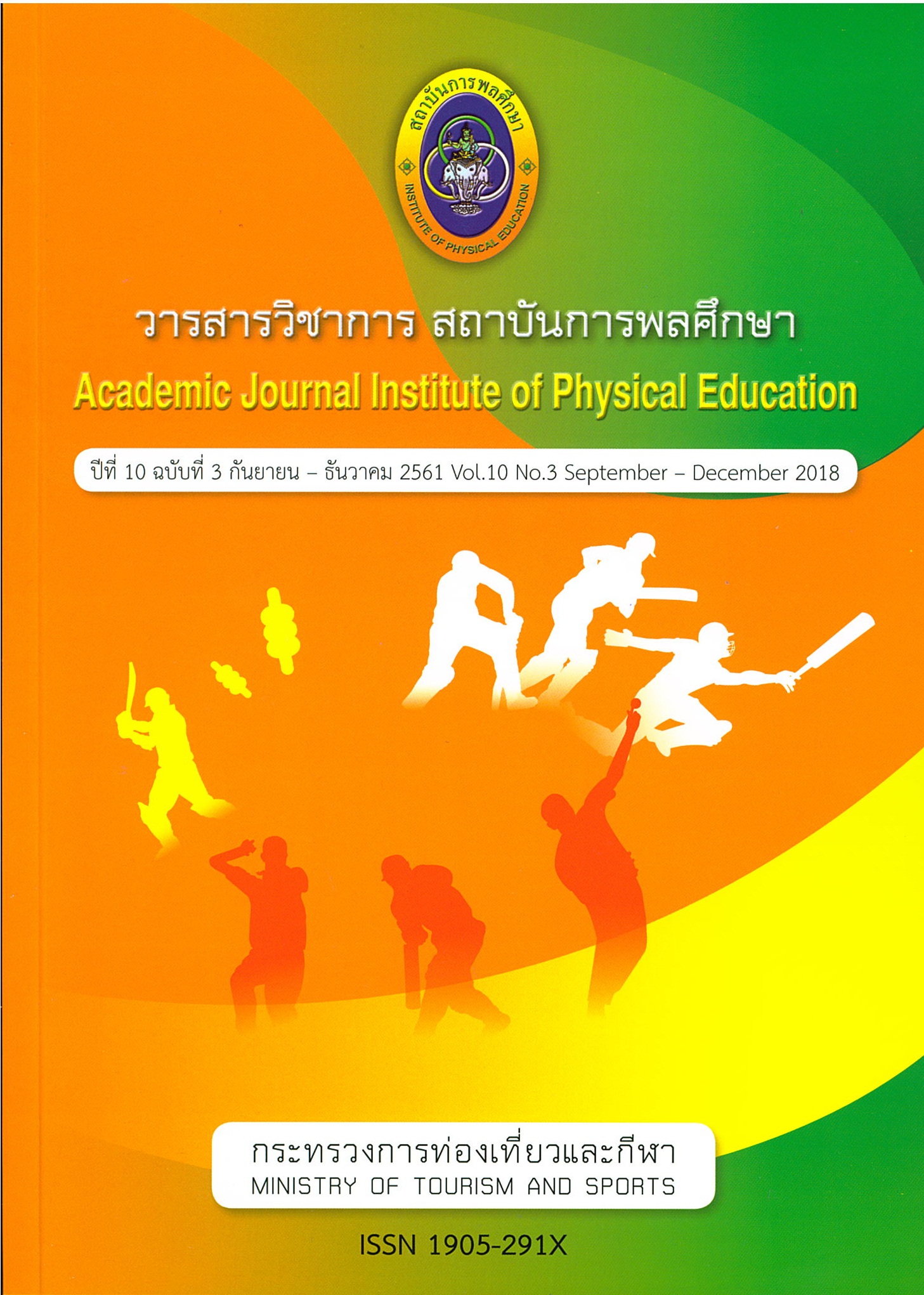Level of Maximal Oxygen Consumption of Students From Institute of Physical Education, Yala Campus
Main Article Content
Abstract
The purpose of this research was to study and compare the maximum oxygen consumption (VO2 max) of students from Institute of Physical Education, Yala Campus. The volunteer were 191 students from Institute of Physical Education, Yala Campus they were Volunteer Sampling. They were tested by Modified Astrand – Rhyming nomogram. Data wereanalyzed byusingmean, standard deviation, independent t-test, OneWay Analysis of Variance: (ANOVA) and with multiple comparisons testing by LSD method.
The results were as follows:
1. The maximum oxygen consumption (VO2 max) of male students from Institute of Physical Education Yala Campus, the mean was 48.84 ml/kg/min and standard deviation was 10.58 ml/kg/min. The most of maximum oxygen consumption (VO2 max) were good. The maximum oxygen consumption (VO2 max)of female students from Institute of Physical Education Yala Campus, the mean was 53.05 ml/kg/min and standard deviation was 16.43 ml/kg/min. The most of maximum oxygen consumption (VO2 max) were very good. Because of It can be said that female students have higher oxygen content than male students. Most female students enjoy exercise and are athletes. Representative of the Institute The training and competition at all times. As a result, female athletes have very good physical fitness.
2. The results of the analysis of the student’s maximum oxygen capacity Classified by sex and grade. In comparison with the sport standard in Sports Authority of Thailand; SAT (2006), the highest oxygen content was found in males, 34.51% in males and 34.51% in females. Very good. When classified by grade level, the first and second year students were able to use the highest oxygen content. Very good. 46.62% and 37.10%, respectively, and female students in the 1st - 4th year had the highest oxygen consumption. Very good. 80.81%, 61.50%, 46.67%, and 30%, respectively.
3. When compared of the highest mean oxygen capacity between each year students. subjects. It was found were significantly different, at 0.05 level of confidence.
4. The students in Yala Campus, Year 1-4, found that female students had the highest oxygen consumption. not different And students in Years 1-4 have the ability to use maximum oxygen. The difference was significant at 0.05 because of the first year students are more interested in physical exercise than the third year students. Sports Science Center The first year students have more statistics than the third year students.
Article Details
The published article is a copyright of the Academic Journal of Thailand National Sports University. The passage appeared in each article in this academic journal is a perspective of each author which is not related to the journal. Each author is required to be responsible for all components of his/her own article. If there are any mistakes, each author must be responsible for those mistakes on his/her own.
References
การกีฬาแห่งประเทศไทย. (2549).การทดสอบสมรรถภาพทางกาย นักกีฬาเยาวชนแห่งชาติและนักกีฬาแห่งชาติ. กรุงเทพฯ: กองสมรรถภาพการกีฬา ฝ่ายวิทยาศาสตร์การกีฬา การกีฬาแห่งประเทศไทย.
ชัยยุทธ สุทธิดี. (2552). ผลของการฝึกด้วยโปรแกรมการเต้นแอโรบิกที่มีต่อความสามารถในการใช้ออกซิเจนสูงสุดและค่าดัชนีมวลกาย. ปริญญานิพนธ์กศ.ม. (พลศึกษา).กรุงเทพฯ: บัณฑิตวิทยาลัยมหาวิทยาลัยศรีนครินทรวิโรฒ. ถ่ายเอกสาร.
ชูศักดิ์เวชแพศย์และ กันยา ปาละวิวัธน์. (2546). สรีรวิทยาของการออกกำลังกาย. พิมพ์ครั้งที่4. ม.ป.พ.
ณัฐพลไตรเพิ่ม. (2556). การออกกำลังกายแบบแอโรบิกในปริมาณงานที่แตกต่างกันที่มีผลต่อสมรรถภาพการใช้ออกซิเจนความจุปอดและเปอร์เซ็นต์ไขมันในร่างกาย.วิทยานิพนธ์ศึกษาศาสตรมหาบัณฑิต, สาขาวิชาพลศึกษา, บัณฑิตวิทยาลัย, มหาวิทยาลัยขอนแก่น.
ภัทรพรสิทธิเลิศพิศาล. (2554). เอกสารประกอบการสอนรายวิชา 518724การวัดความสามารถในการใช้ออกซิเจน. เชียงใหม่: ภาควิชากายภาพบำบัด คณะเทคนิคการแพทย์มหาวิทยาลัยเชียงใหม่.
American College of Sports Medicine. (2014). High – intensity training. Retrieved from httpp://www.acsm.org
American College of Sports Medicine (2014). ACSM’s Guidelines for Exercise Testing and Prescription (9th ed.). Wolters Kluwer/Lippincott Williams & Wilkins.
Astrand, P.O. & Ryhming, I. (1954). A nomogram for calculationof aerobic capacity [physical fitness] from pulse rate during submaximal work. Journal of Applied Physiology, 7, 218–221.
Krejcie, R. V. & Morgan, D. W. (1970). Determining Sample Size for Research Activities. Educational and Psychological Measurement, 30(3), pp. 607-610.
Heyward, V.H. (2008). Advanced Fitness Assessment and Exercise Prescription. 3rd ed. Illinois: Human Kinetics Publishers, Champaign.


